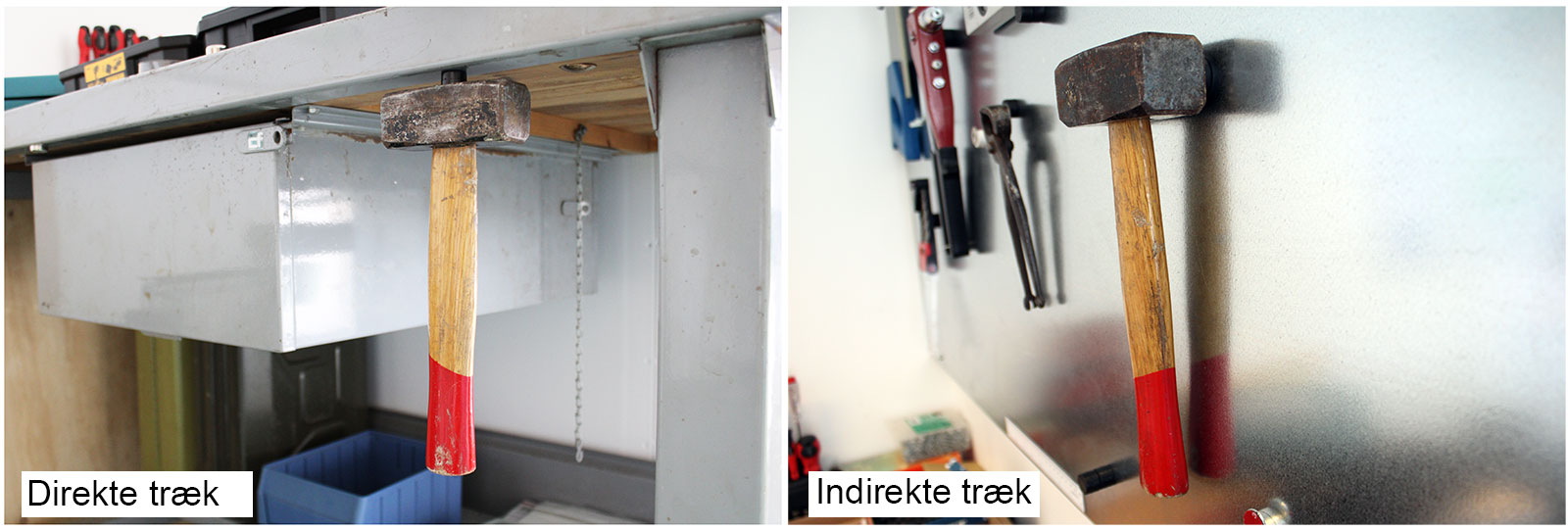Direct or indirect moves?
There is a big difference between whether you hang something in a direct or an indirect move. And the easiest thing would be to be able to make a formula for calculating this, but there are so many factors that come into play in relation to whether there are direct or indirect moves, so in this post we try to come up with concrete situations that make enable you to calculate your own strength requirements based on direct/indirect pulls.
What is the difference?
- Direct pull is when the magnet direction points in the same direction as what is to be hung,
- Indirect pull is when the magnet direction points horizontally, but your object hangs vertically
When you hang something with a magnet - e.g. a magnetic hook - then you must make the best use of the magnetism, and you do this by not overloading the magnet in the form of a crooked pull in relation to the center of the magnet. But if you need to hang something in an indirect way, it can be done, as long as you multiply the weight of the object by 4-6 times to calculate the need for magnetic strength.
Here we come. with 3 specific examples:
Example 1: hanging a hammer
If you put a magnet in the ceiling or under a metal shelf and hang the hammer on the magnet, there will be a direct pull on the magnet , as both parts point in the same direction, and as long as the hammer does not swing, the pull is continuously direct. But if you put a magnet on e.g. a metal surface on the wall, or if the hammer is to be hung on the roof of a car, where it can move back and forth, the hammer will pull in the opposite direction to the core of the magnet, and it is thus an indirect pull.
< p>
You can therefore content yourself with choosing a strength of approximately the same weight as the hammer in a direct pull. But if it's going to hang on the wall, you need 4 times the strength of the hammer's weight, and if it can swing, multiply the magnetic strength by 6 times the weight of the hammer to calculate your strength requirement for setting up your hammer . the direction of the magnet points horizontally while the calendar hangs vertically. But if you instead have the opportunity to hang it on e.g. a metal surface in the ceiling, you get a direct pull on the magnet as long as the calendar hangs still. But if there is room for the calendar to oscillate or dangle, an indirect pull does occur, as a calendar "in swing" will pull skewed in relation to the core of the magnet.

When calculating strength requirements, you must pay attention to whether the pull is direct or indirect. However, you must also be aware that a smooth surface such as an alm. refrigerator or a whiteboard makes it harder for the magnet to stick without sliding down when you hang something on the magnet in an indirect pull. So the calculation when setting up on a metal surface will be that you need to use approximately the same weight strength on the magnet as the calendar weighs if you hang your calendar in a direct pull (from the ceiling), but if the calendar is to be hung on the wall on a metal surface, you use a force that is 4 times as high as the weight of the calendar. If a calendar is hung with the possibility of swinging or on a smooth surface, an even greater challenge arises with skewed pull on the magnet, and here you must use 6 times as much strength as your calendar weighs.
Example 3: hanging a lamp
Setting up lamps can be done in both direct and indirect drafts, but it is still slightly different compared to the 2 examples above, as there is a difference between lamps. Below we explain what you must take into account if you have a hanging lamp with a cord or want to attach the lamp to a pipe or steel wire. The calculations for magnet selection are inserted directly into the text for the two lamp examples and do not appear in a separate section under photos, as they do above in the examples with the hammer and the calendar.
Hanging lamp with cord: If you hang a lamp on a cord with magnetic attachment to the ceiling, you have a direct draw, but the possibility of oscillations due to the cord still causes a situation to arise , where there is an indirect pull on the magnet. If it is slight fluctuations such as a small gust of wind that moves the lamp a maximum of a few centimetres, then you will probably be able to suffice with multiplying your strength requirement by 4 times the total weight of the lamp and the cord. But if we are exposed to major fluctuations, or if the lamp is to be hung in a building with frequent vibrations from e.g. metro or heavy traffic, you have to count on up to 8 times the lamp's weight, as there is a big difference between the dimensions of the cord and the lamp itself, which will challenge the magnet extra. If, on the other hand, the lamp is to be hung from the wall, where there are not so many vibrations, you can multiply the weight of the lamp by 4 to get the magnetic strength required.
Lamp on a fixed pipe or steel wire: A lamp that is more "fixed" fixed on a wire in a pipe or with flexible telescope will have less tendency to move and as long as the weight when suspended from the ceiling will be stable in the vertical direction, you have a direct pull on the magnet. However, you should know that the slightest drop in the ceiling or a swing in the lamp will cause an indirect pull, and therefore we would never recommend that you choose the same strength magnet as the lamp weighs. Better be on the safe side and go with a factor of 3 or more. The same applies if the lamp is to be hung in a building with frequent vibrations from e.g. subway or heavy traffic, and here we recommend that you go with up to 8 x the weight of the lamp. If, on the other hand, a lamp is to be hung on the wall, then with a lamp of this type you will immediately have a direct pull, because the lamp points in the same direction as the direction of the magnet. But since the largest part of the weight of the lamp comes very far away from the core of the magnet, it will still give an indirect pull (in other words: if something takes up a lot of space, the weight load does not come directly on the magnet, and it therefore becomes an indirect pull ).
Hanging on smooth surfaces
As we mention above in our example of hanging a calendar, smooth surfaces challenge the magnets extra. This applies, for example, to refrigerators and whiteboards but also glass boards.
Hanging on a refrigerator or whiteboard
In relation to hanging items on a refrigerator or a whiteboard, you must use a factor 2 extra of the strength requirement. And since a refrigerator and a whiteboard usually hang vertically with the magnetic direction horizontal, you don't just have to multiply by 4 to account for the indirect pull, but instead you have to multiply the weight of your object by 6 (i.e. 2 times extra) to get a magnet that can handle the smooth surface at the same time.
Hanging on glass boards
When you have to hang something on glass boards, you have both a smooth surface and a distance to the metal plate behind the glass, which is the magnetic part of the board. And it requires even more from your magnet, as the loss of strength in relation to the distance (thickness of the glass plate) must also be calculated. Read more about valg of magnets for glass boards here.